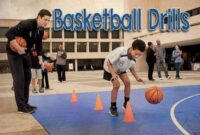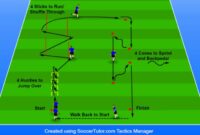Football speed drills are essential for players looking to improve their performance on the field. From increasing acceleration to enhancing agility, these drills play a crucial role in taking your game to the next level. Get ready to dive into the world of speed training and discover how you can become a faster and more agile player.
Importance of Speed in Football: Football Speed Drills

Speed is a crucial factor in football as it can make a significant difference in a player’s performance on the field. The ability to move quickly can give a player an edge over opponents, allowing them to react faster, make swift plays, and cover more ground during a match.
Impact of Speed on Performance
Speed can impact a player’s performance in various ways. It allows players to outrun defenders, create scoring opportunities, and track back defensively. Quick acceleration and top speed can help players break away from the opposition, make crucial tackles, and close down opponents effectively.
Role of Speed in Different Positions
Speed is essential for players in different positions on the field. For example, strikers need speed to beat defenders and score goals, while wingers rely on their pace to bypass opponents and deliver crosses. Defenders with speed can recover quickly and prevent scoring chances, while midfielders need speed to cover ground and support both the attack and defense.
Types of Football Speed Drills

When it comes to improving speed in football, there are various types of drills that players can incorporate into their training routines. Each type of speed drill serves a specific purpose and targets different aspects of speed development, helping players enhance their overall performance on the field.
Sprint Drills
Sprint drills focus on improving an athlete’s acceleration and maximum speed. These drills usually involve short bursts of high-intensity running over a specific distance. By practicing sprint drills, football players can improve their ability to quickly accelerate from a standstill position and reach their maximum speed in a short amount of time. Examples of sprint drills include 40-yard dashes, shuttle runs, and flying sprints.
Agility Drills
Agility drills are designed to enhance a player’s ability to change direction quickly and efficiently. These drills often involve lateral movements, quick cuts, and directional changes to simulate the unpredictable nature of the game. By incorporating agility drills into their training, football players can improve their footwork, balance, and overall agility on the field. Examples of agility drills include ladder drills, cone drills, and zig-zag sprints.
Interval Training, Football speed drills
Interval training combines short bursts of high-intensity exercise with periods of rest or lower-intensity activity. This type of training helps improve cardiovascular endurance, speed, and overall fitness levels. In football, interval training can help players increase their stamina, recover faster between plays, and maintain a high level of performance throughout the game. Examples of interval training drills include repeated sprints, tempo runs, and fartlek workouts.
Plyometric Drills
Plyometric drills focus on explosive power and quick muscle contractions. These drills involve jumping, bounding, and other high-impact movements to improve an athlete’s ability to generate force rapidly. By incorporating plyometric drills into their training regimen, football players can enhance their jumping ability, acceleration, and overall power on the field. Examples of plyometric drills include box jumps, depth jumps, and squat jumps.
Hill Sprints
Hill sprints involve running uphill to increase resistance and challenge the muscles in a different way. This type of drill helps improve a player’s strength, power, and speed while also enhancing their cardiovascular fitness. By incorporating hill sprints into their training routine, football players can develop the necessary strength and endurance to perform at their best during games. Hill sprints can also help prevent injuries by strengthening the muscles and joints.
Techniques for Effective Speed Training
Proper speed training techniques are essential for football players looking to improve their performance on the field. By focusing on running form, acceleration, top speed, and agility, players can enhance their overall speed and agility.
Proper Running Form for Maximizing Speed
Having the correct running form is crucial for maximizing speed on the football field. Here are some key tips to improve running form:
- Maintain an upright posture to optimize stride length and frequency.
- Keep arms bent at 90-degree angles and swing them back and forth efficiently.
- Land on the balls of your feet to propel yourself forward with each stride.
- Engage your core muscles to provide stability and power during acceleration.
Tips for Increasing Acceleration and Top Speed
Increasing acceleration and top speed requires targeted training and focus. Here are some tips to boost your speed:
- Incorporate sprint drills into your training routine to improve explosive power.
- Work on strength training exercises, such as squats and lunges, to enhance leg muscle power.
- Practice interval training to build endurance and speed over short distances.
- Focus on proper breathing techniques to optimize oxygen intake during sprints.
Incorporating Agility Training with Speed Drills
Agility is a key component of speed in football, as players need to change direction quickly and maintain control while sprinting. Here’s how you can incorporate agility training with speed drills:
- Set up cone drills to practice quick changes in direction and footwork.
- Include ladder drills to improve coordination and agility in different movement patterns.
- Utilize reaction drills to enhance decision-making and responsiveness during speed exercises.
- Combine agility ladder drills with sprint intervals to simulate game-like scenarios and improve overall speed and agility.
Periodization and Progression in Speed Training

Periodization is a crucial aspect of any training program, including speed training for football players. It involves dividing the training program into specific periods or phases to optimize performance and prevent overtraining. When it comes to speed development, periodization helps in managing intensity, volume, and recovery to ensure continuous progress and reduce the risk of injuries.
Sample Speed Training Program
- Week 1-4: Focus on building a solid foundation with basic speed drills such as sprints and agility ladder drills.
- Week 5-8: Increase intensity by incorporating resistance training and hill sprints to improve power and acceleration.
- Week 9-12: Shift towards speed endurance with longer sprints and interval training to enhance stamina and maintain speed throughout the game.
Importance of Periodization in Speed Development
- Allows for proper recovery and adaptation to training stimulus.
- Prevents burnout and overtraining by strategically varying intensity and volume.
- Promotes long-term progress by systematically progressing through different phases.
Progressing Intensity and Volume in Speed Drills
- Gradually increase the speed or distance of sprints to challenge the athletes without risking injury.
- Incorporate advanced drills like resisted sprints or change of direction drills to keep the training sessions challenging.
- Monitor athletes’ performance and adjust the training program based on their progress to ensure continued improvement.
Injury Prevention in Speed Training
In any athletic training program, injury prevention is a critical aspect to consider, especially when it comes to speed training in football. The high-intensity nature of speed drills can sometimes increase the risk of injuries if proper precautions are not taken. Let’s delve into common injuries associated with speed training and preventive measures to reduce the risk of injuries.
Common Injuries Associated with Speed Training
Speed training can lead to various injuries, including muscle strains, ligament sprains, tendonitis, and even stress fractures. These injuries can occur due to overexertion, improper technique, or inadequate warm-up routines. It is essential to be aware of these potential risks to take necessary precautions.
Preventive Measures to Reduce the Risk of Injuries
1. Proper Warm-up and Cool-down: Before engaging in speed training sessions, athletes should perform dynamic warm-up exercises to prepare the muscles for intense activity. Similarly, incorporating static stretches during the cooldown phase can help prevent muscle tightness and reduce the risk of strains.
2. Gradual Progression: Avoid sudden spikes in training intensity or volume. Gradually increase the intensity of speed drills to allow the body to adapt and reduce the risk of overuse injuries.
3. Correct Technique: Focus on maintaining proper form and technique during speed training exercises. This can help prevent unnecessary stress on muscles and joints, reducing the likelihood of injuries.
4. Rest and Recovery: Adequate rest between training sessions is crucial for allowing the body to recover and repair. Overtraining can lead to fatigue and increase the risk of injuries, so it’s essential to listen to your body’s signals.
Importance of Warm-up and Cooldown Routines for Injury Prevention
Warm-up and cooldown routines play a vital role in injury prevention during speed training. A thorough warm-up increases blood flow to the muscles, improves flexibility, and enhances overall performance. On the other hand, cooldown exercises help reduce muscle soreness, prevent stiffness, and promote recovery. By incorporating these routines into your training regimen, you can significantly reduce the risk of injuries and optimize your athletic performance.
Explore the world of football speed drills and take your game to new heights. With the right training and techniques, you can unlock your full potential on the field and outpace the competition. Start incorporating these drills into your routine today and watch your speed soar.
When it comes to improving flexibility, the best yoga poses for flexibility are essential. These poses not only help in increasing flexibility but also promote relaxation and stress relief. Some popular poses include Downward Dog, Forward Fold, and Pigeon Pose. Check out this article for a detailed guide on how to perform these poses effectively.
For runners looking to improve their performance, incorporating stretching exercises for runners is crucial. These exercises help prevent injuries, improve flexibility, and enhance overall running efficiency. Some effective stretches include quad stretch, calf stretch, and hamstring stretch. Discover more about these stretches in this informative guide.
Preparing for long-distance running requires a specific training regimen. Long-distance running training involves building endurance, speed, and mental toughness. It includes strategies like interval training, hill repeats, and long runs. Find out more about how to train effectively for long-distance running in this comprehensive training guide.



